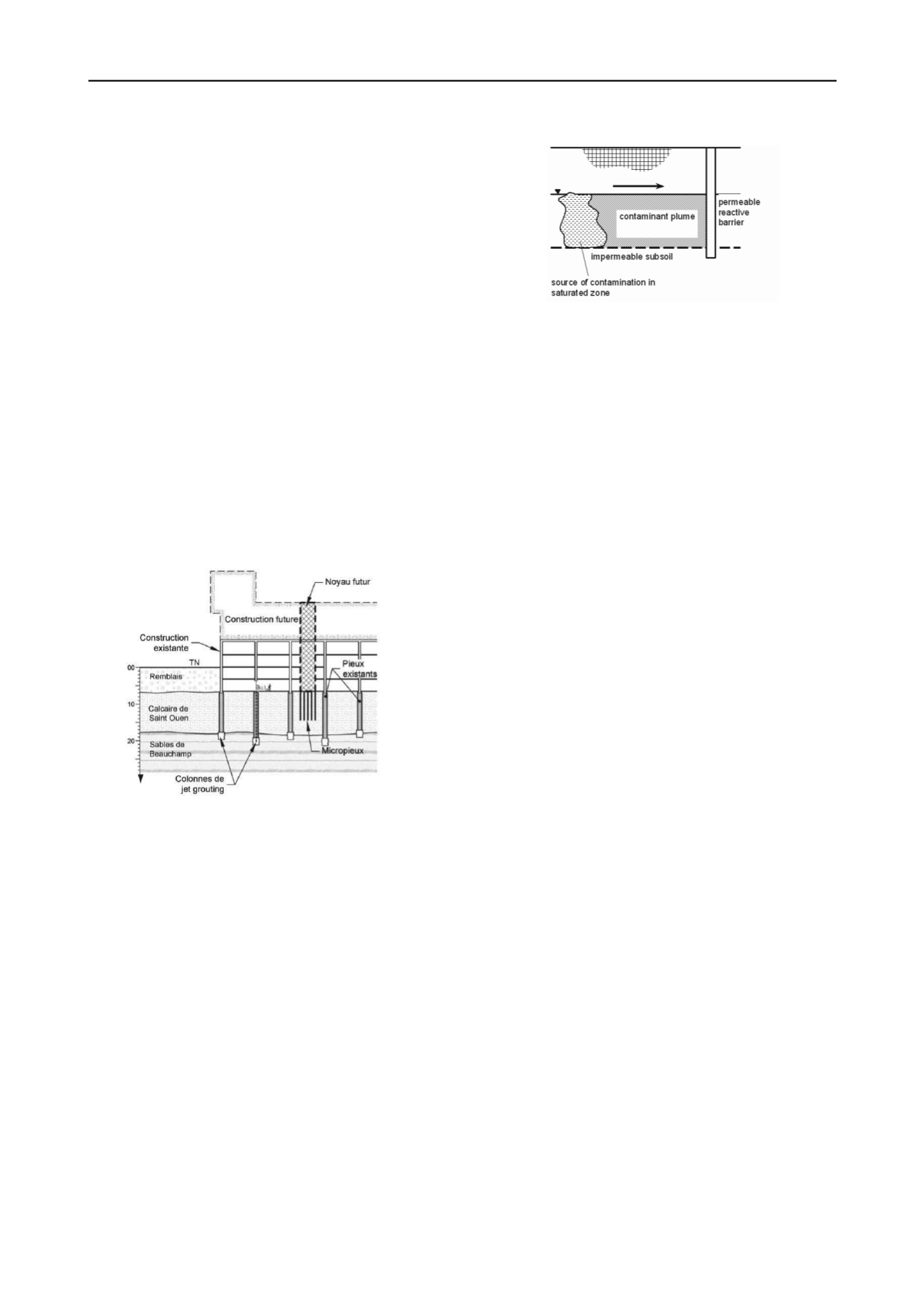
3160
Proceedings of the 18
th
International Conference on Soil Mechanics and Geotechnical Engineering, Paris 2013
characterization that consisted of collection of data from
adjacent sites, stress-path tests on bore hole samples, suction
tests, and estimation of coefficient of earth pressure at rest, on
monitoring of an instrumented basement of an adjacent hotel
structure, and on linear and pseudo-nonlinear soil structure
interaction analysis considering plate-on-spring approach, the
piled raft foundation was designed with the piles used as
settlement reducers. The design also ensured that there was
minimal disturbance to the adjacent structures.
Reuse of foundations is often preferred over new
foundations because reuse reduces waste disposal and
environmental impact. Guilloux et al. presented three case
studies of foundation reuse projects in Paris and Pantin. Figure
10 shows a cross section of one of the rehabilitation projects in
Paris in which the existing pile foundations were strengthened
by jet grouting and additional support was provided by newly
installed micropiles. Guilloux et al. concluded that a site
specific approach involving proper site characterization,
condition assessment of existing foundations, delineation of
existing and new foundation geometry, accurate estimation of
changes in load, deformation and capacity during the
construction process, consideration of different possible
construction alternatives, proper choice of reinforcement
technique, and proper monitoring is required for successful
reuse of foundations. Vaníček et al. also advocated reuse of
foundations particularly in the context of brownfield
redevelopment.
Figure 10. A cross section of foundation reuse project of Calberson
warehouses, MacDonald Boulevard, Paris (Figure 1 of Guilloux et al.).
3.4 Subsurface remediation and site redevelopment
Redevelopment of contaminated sites including brownfield sites
and landfills is an important part of sustainable geotechnics.
According to Vaníček et al., brownfield redevelopment involves
an initial reconnaissance study involving site characterization
and economic feasibility study, followed by detailed site
investigation, site remediation, and construction of new
facilities at the site. Site remediation involves ground
improvement by physical means (e.g., compaction and clay
injection) and chemical treatment using encapsulation,
permeable reactive barrier (Figure 11) and chemical
stabilization. Vaníček et al. also provided an example of use of
coal mine sites in Czech Republic where clayey overlays
covering coal seams were excavated during mining activities
and subsequently backfilled, and constructions were made on
the mine sites using the mine-spoil heaps.
Figure 11. Site remediation by permeable reactive barrier (adapted from
Figure 4 of Vaníček et al.).
McIntosh and Barthelmess provided a case study of reuse of
a derelict (puticible waste) landfill site at Unanderra, NSW,
Australia. Different geotechnical and geoenvironmental studies
were conducted to assess the potential of the landfill site for
construction. Environmental monitoring included testing of
groundwater for contaminants and metals, and of gas
monitoring wells for methane, hydrogen sulphate, and carbon
dioxide. Monitoring for vibrations, noise and dust produced
during site preparation was also conducted. The landfill density
was increased by dynamic compaction, and environmentally
neutral coal washery rejects locally present in the landfill site
were used as cheap backfill material. A leachate control pond
was constructed to receive the leachate during compaction and
also to manage storm water on a long-term basis. Future civil
and building services have been designed such that they do not
penetrate the capping layer of the landfill. Driven steel piles
bearing on underlying latite bedrock will be designed as
building foundations. Flexible aprons will be provided between
buildings and adjacent car parks, walkways and recreation
areas, and raft slabs may be feasible for some lightweight,
single-story buildings. The environmental design includes
capping consisting of HDPE, GCL, geotextile fabric, 300 mm
gravel gas drainage layer with a reinforcing geotextile, a gas
drainage layer forming part of the cap, and leachate collection
drains.
3.5 Sustainability assessment
The foregoing studies show that geotechnical engineering can
contribute significantly to solutions of sustainability problems.
Most studies are based on the common notions of sustainability
like recycling, reuse, and use of alternate materials, technologies
and resources. However, whether such new approaches are
actually sustainable or not cannot be ascertained without proper
assessment using, for example, whole life cost analysis and risk
based performance analysis. Thus, a sustainability assessment
framework is necessary for geotechnical projects to ascertain
the relative merits of different options available for a project.
Frischknecht et al. performed a comparative life cycle
assessment (LCA) of a pavement filtration system by comparing
the performance of a gravel filter and a geosynthetics-based
filter drain with the same hydraulic conductivity of 0.1 mm/s or
more and with the same design life of 30 years. Life cycle
inventory (LCI) of gravel and geosynthetics filter for a 1 m
2
functional unit was performed
Table 1 shows some key
figures of LCI. Polypropylene granules was used as the basic
material for the geosynthetics filter, and the LCI of
geosynthetics manufacturing was performed using the ecoinvent
data v2.2 based on the categories of raw materials, water,
lubricating oil, electricity, thermal energy, fuel for forklifts and
factory building. The environmental impact assessment (EIA)
was performed considering eight impact indicators: cumulative
energy demand, global warming potential, photochemical ozone
formation, particulate formation, acidification, eutrophication,
land competition, and water use. Based on the study,
Frischknecht et al. found that the geosynthetics based filter layer
causes lower environmental impact than the conventional
gravel-based drain and that the environmental impact of


